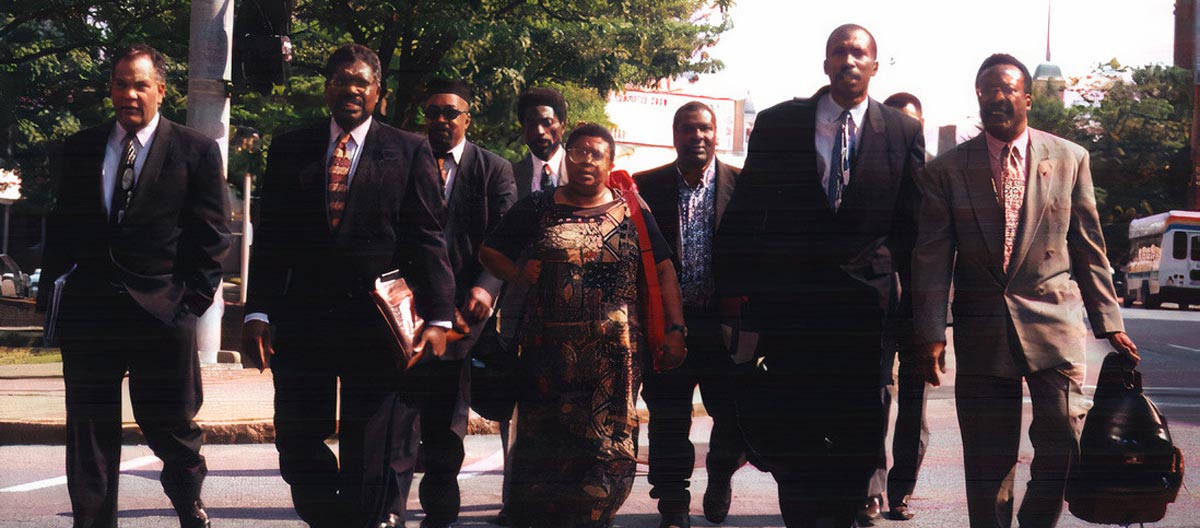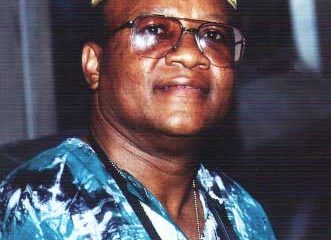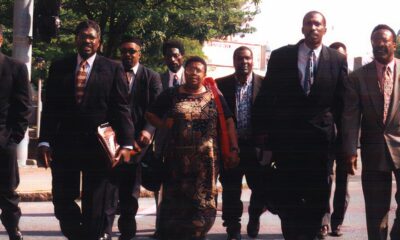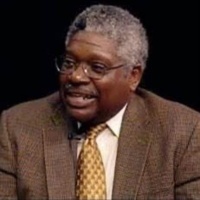Black History
Alton Maddox in Poughkeepsie

Reprints of excerpts from OTP’s 44-page Evidence Concealed, Now Revealed
award-winning feature published in 1998 About the Tawana Brawley case, resumes with …“A DETECTIVE’S STORY” by Graham B. Weatherspoon Pt II
Our Time Press August 1998 Part 2
Graham B. Weatherspoon, NYPD (ret.) “20-year veteran of the New York Transit Police, and the New York Police Department, 10 years as a detective. A member of 100 Blacks in Law Enforcement, Graham is certified by the state to conduct sex crime investigations and has performed a number of them involving adults and children. Graham has been in the Pagones defamation suit courtroom for the past eight months. A frequent contributor to OTP, Graham gave us the following interview based on sworn testimony, except where indicated.
David Greaves: Didn’t her family or anybody go up to the hospital to get her, to bring her clothes?
She was sent home in a sheet, and I believe she still had some feces and other material in her hair, as I recall from the testimony of the nurses. On the evening of the 30th, Hilda Kolgut of the FBI in the Southern District, working out of Newburgh, went with Marjorie Smith of the Dutchess County District Attorney’s office. Smith is the sex crimes Assistant District Attorney, trained in molestation of children and violation of women. She has also been trained at the college of D.A.s of the State of New York, and taught sex crime investigation to various D.A.s around the State. She has also taken some training at Princeton relative to the subject. Senior Assistant District Attorney, an African American, C. Otto Williams, was present as well as a detective from the Dutchess County Sheriff’s office. They went to Tawana’s house in the evening. When they got there, the family members were there, the neighbors were there, and members of the NAACP, the Human Rights Commission; there were a bunch of people in the house. They came to interview Tawana to find out what happened and commence an investigation. They knew that she did not want to be near any white men. The person who conducted the interview was a white male detective from the sheriff’s office. He did an excellent job in his interview. His interview consisted of ten or eleven pages of questions and answers. One of the things people say is that Tawana never spoke. Tawana spoke in the hospital, and then she spoke to the people there at the house.
What did she say?
She repeated her statement that five or six white men had attacked her. She was walking home, she got off the Shortline bus and was walking up the road, it’s a very dark road, a car pulled up, a man got out, showed a badge, it was a police officer, and he grabbed her. She tried to get away; he punched her in the back of the head and threw her in the back seat of the car. There was one other man whose face she didn’t see who was driving the car. She was driven to another location where there were more men. She said that these men raped her repeatedly over a period of time. She was also found to have urine in her mouth at the time that she was found. It’s in the medical reports. It was later determined that she had chlamydia, which is another sexually transmitted disease, which comes as a result of penile penetration. There was a second sexually transmitted disease she had as well. In the medical reports, there is a notation of the condition of her pubic area. There was a collection of blood around her pubic area from the constant pounding. As a matter of fact, the doctor who examined her wrote down “Sexual assault” as a possible cause of her condition.
So her statement to the investigators was buttressed by the doctor’s examination.
Yes. Now she spoke with this detective for about forty-five minutes. She gave verbal answers, which he noted in his report. The sex crimes ADA, Marjorie Smith, only had one or two questions. One, she wanted to know what was the color of the badge that the police officer showed, was it gold or silver, which is a sensible question. The second one was what did it feel like when they urinated in your mouth?
That was her contribution?
Yes. The detective prepared an investigative report and handed it in to Marjorie Smith the following morning. Marjorie Smith claims that she took no notes, and she felt that the detectives’ work was very exemplary and very thorough. But when Marjorie Smith came to court ten years later, she said that Tawana gave no substantive answers whereby they could conduct an investigation. But she got a ten-page report of questions and answers.
Now with that ten-page report, if you were an investigator on the case, and you took that report to your supervisor, what would normally happen?
What normally happens in New York City, you did your first DD5, which is the interview of the complainant, and you have noted all of the comments of the victim. From that, you have a case to work on.
What would you do?
If you’re telling me that a police officer raped you, I now have to move on that fact, on the description of the man. I now would be looking for any white male who had sandy blond hair and a mustache as a possible suspect. With the technology we have, you can just punch that into a computer and it’ll give you the photographs of all white male officers with sandy blond hair and mustaches in the police department. Because my next move would be to try and identify this individual.
Realizing that the victim has been traumatized, what I want is to make sure that the victim is stable and able to make the identification. You don’t necessarily rush to do identification the next day. I want to make sure that emotionally and psychologically, my victim is taken care of. It was not at the suggestion of St. Francis Hospital that they seek psychological help for Tawana. It was not at the suggestion of the sex crimes D.A. that they seek psychological help for Tawana.
It was at the suggestion of Alton Maddox, her attorney, that she seek psychological help. If Marjorie Smith were credible, if she were credible as an advocate for sex crime victims, that’s one of the first things that she would have done. She also would have gone to the hospital and talked with the medical personnel to find out exactly what her condition was when she was brought in, and what evidence and materials do we have. The plastic bag that Tawana was in when she was found never got to the hospital. The bag itself contained evidentiary material.
Can you get fingerprints off of a plastic bag?
You can get good fingerprints off a plastic bag. That bag never made it to the hospital.
So now you have the written statements of the victim, you have a rape kit, what happened after that?
There were a number of problems here. Because Tawana was saying that a member of law enforcement raped her, she became a victim a second time. They interviewed her on the 30th of November. On the first, of December, the detective submits his report on the interview. No steps are taken by the District Attorney’s office or the sheriff’s office to secure all of the possible evidence. On the second of December, three days following the initial interview, a part-time police officer from Fishkill named Harry Crist, is found dead in his apartment. This is interesting because of the testimony of mailman Tim Losee.
Mailman Losee recalled seeing a car, which looked like an old police cruiser, roaming around the area of the Pavilion Complex, with four white males in it, one of which looked very close to Scott Patterson.
How did he know it looked like Patterson?
What happened was that he noticed the car cruising the area very slowly, as though these guys were looking for somebody. He looked at the vehicle, the number of men in it, and the driver. He later saw a picture of Scott Patterson in the newspaper and realized he looked like the driver of the car.
He noticed them because of the way they were driving?
Right. They weren’t just driving. They were creeping through the area. He said it was either the 28th or the 29th that he saw this car. Now Tawana was found on the 28th. The description of the car that Tim Losee the mailman gave, matched that of the car that was owned by Harry Crist. Now, Pagones testified that he and the guys were in Danbury, Connecticut that day.
Four guys in the same car?
In the same car. Losee said he had given the description of Harry Crist’s car to DA Grady and he also made a statement to the New York State Police. Grady realized after hearing this, that there had to be a connection between Pagones, Crist, and the others relative to the placement of Tawana’s body. You see, Tim Losee did not come forward until after the Grand Jury report had been written.
Why not?
Mr. Losee wanted to see how this investigation would go. And when the official report came out, he realized it was not on the up and up. This is a white male who had nothing to gain by going along with the program on behalf of Tawana, but he realized that something was awry relative to the investigation, he had information and was willing to give it but it was not called for.
So Harry Crist wound up dead three days after a car just like his was seen near where Tawana was found. All of the authorities said he committed suicide. The State Police said he committed suicide, the District Attorney said he committed suicide, and of course, the media reported that he committed suicide. Tawana happened to see Harry Crist’s photo in a newspaper or magazine, and stated “That was the cop that stopped me.”
Who did she say that to?
She said that to her parents.
Who did the parents tell that to?
All the proper authorities, the DA, the FBI, everybody.
Harry Crist is found dead. If you’re an investigator, and the victim says, “That’s the guy,” wouldn’t you investigate that guy?
Definitely. You see one of the funny things is that Steven Pagones said that he was with Harry Crist the night before he died. Independent of the investigation, this is a statement he made. The night before Crist died, Scott Patterson also said he was with Harry Crist, in Harry’s apartment, lifting weights. He said he had left his wedding band in Harry’s apartment. He had taken it off so it wouldn’t dent the iron. He had forgotten about it, gone home, and went back to get it the next morning. He had a key to Harry’s apartment.
Harry’s aunt lives downstairs. She said she never heard a shot. But Harry is dead in his apartment from what they said was a self-inflicted gunshot wound.
Meanwhile, when it comes over the radio that a police officer has been found dead, apparent suicide, Steven Pagones says, that he was in the Fishkill State Police barracks, working on a forgery case and he was talking to the trooper involved in the case. When asked who the trooper was he doesn’t recall. When asked who the judge was who had the case, he doesn’t remember. When asked who the defendant was in the case, he doesn’t remember. But he said he was there when the call came in and he inquired, “Who’s the cop?” They said, “A guy named Crist.” He said, “That’s my friend.” The fact is, Harry and Steve were not close friends, they were more like acquaintances. The irony is that just a few days prior to Crist’s death, he had pulled a gun on Steven Pagones and threatened to shoot him.
Where does that come from?
From Steven’s own mouth. They had gone to Danbury, Connecticut to quote, “Do some shopping for their girlfriends for Christmas.”
Now Tawana was found on the 28th. When did they say they were in Danbury?
The 28th.
The three of them?
Yes. Crist, Pagones, Patterson and Branson.
Four grown men?
GW: Four grown men.
They went shopping together at the mall?
At the mall, buying gifts for their girlfriends.
(Retired detective Graham B. Weatherspoon was a member of Bernice Elizabeth Green’s reporting and producing team for OTP’s Evidence Concealed, Now Revealed, which won a New York Association of Black Journalists award for investigative reporting. Weatherspoon is currently a commentator and constant guest speaker on social, television and radio media.)
Part 3 next week









